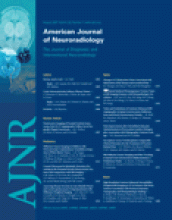Abstract
BACKGROUND AND PURPOSE: Cerebral white matter changes, termed leukoaraiosis (LA), appearing as areas of increased signal intensity in T2-weighted MR images, are common in elderly subjects, but the possible correlation of LA with cognitive or motor deficit has not been established. We hypothesized that histogram and voxel-based analyses of whole-brain mean diffusivity (MD) and fractional anisotropy (FA) maps calculated from diffusion tensor imaging (DTI) could be more sensitive tools than visual scales to investigate the clinical correlates of LA.
MATERIALS AND METHODS: Thirty-six patients of the Leukoaraiosis and Disability Study were evaluated with fluid-attenuated inversion recovery for LA extension, T1-weighted images for volume, and DTI for MD and FA. The extent of LA was rated visually. The normalized total, gray, and white matter brain volumes were computed, as well as the 25th percentile, 50th percentile, kurtosis, and skewness of the MD and FA maps of the whole brain. Finally, voxel-based analysis on the maps of gray and white matter volume, MD, and FA was performed with SPM2 software. Correlation analyses between visual or computerized data and motor or neuropsychologic scale scores were performed using the Spearman rank test and the SPM2 software.
RESULTS: The visual score correlated with some MD and FA histogram metrics (P < .01). However, only the 25th and 50th percentiles, kurtosis, and skewness of the MD and FA histograms correlated with motor or neuropsychologic deficits. Voxel-based analysis revealed a correlation (P < .05 corrected for multiple comparisons) between a large cluster of increased MD in the corpus callosum and pericallosal white matter and motor deficit.
CONCLUSIONS: These results are consistent with the hypothesis that histogram and voxel-based analyses of the whole-brain MD and FA maps are more sensitive tools than the visual evaluation for clinical correlation in patients with LA.
- Copyright © American Society of Neuroradiology












